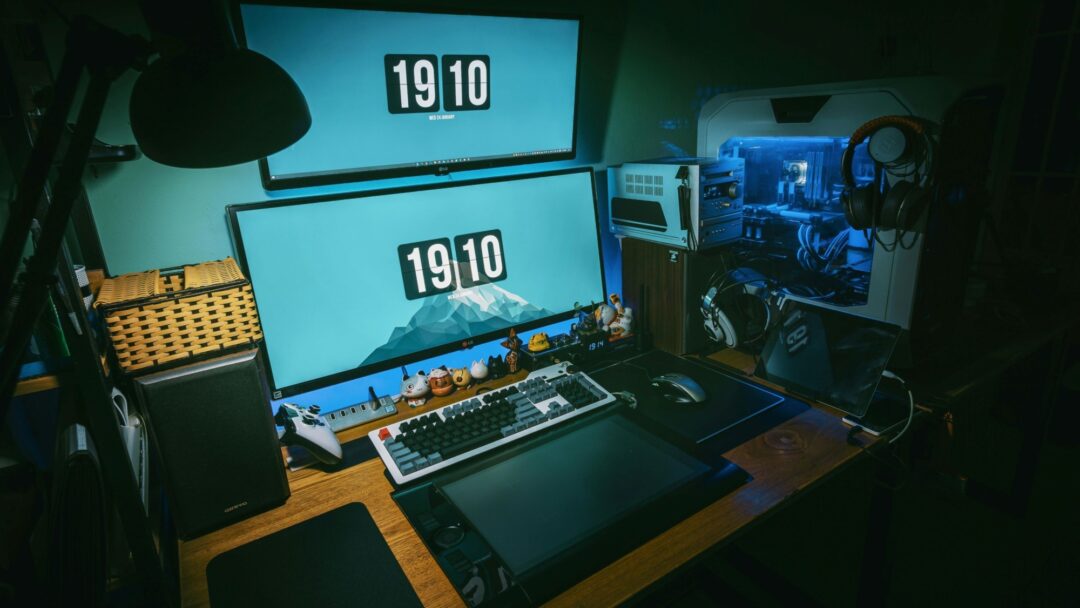Audio
David Woodbridge (part 1)
Ablequest by
2RPH3 seasons
29/11/2024
14 mins
Part 1 of an interview with an Australian expert on low-vision-assistive technology, on AI and other developments.

From Sydney's radio reading station 2RPH comes this series of 15 minute programs exploring developments in assistive technology and initiatives for people living with a wide range of disabilities. The series is presented by Barbara Sullivan, Marni Roper and Elaine Wziontek.
This episode is the first part of an interview with David Woodbridge - a well known authority on assistive technology for people with low, or no, vision, and also a frequent guest on Ablequest. He speaks with Barbara Sullivan about how AI is advancing assistive technology, in particular for people with vision impairment.
Original broadcast date: 29.11.24
Program ID 0:03
(Music) With information on the latest developments in assistive technology and initiatives, 2RPH in Sydney brings you Ablequest.
Marni Roper 0:19
Hello, I'm Marnie Roper. David Woodbridge, who has been a regular guest on Ablequest for over 10 years now, is an excellent source of knowledge on the latest in assistive technology for people with no or low vision. Until recently, David worked as an adaptive technology consultant at Vision Australia for over 25 years. He is now Braille Product Specialist at tech company Humanware, but also continues to research and evaluate new and upcoming technology that can help blind and visually impaired people be more independent.
Barbara Sullivan spoke by phone to David to hear particularly about how artificial intelligence is helping assistive technology be even more effective for people with vision impairment.
Barbara Sullivan 1:06
Hello, David. Great to have you back.
David Woodbridge 1:08
It's good to be back. I'm always keen to talk about technology at a drop of a hand.
Barbara Sullivan 1:13
Well, today we are focusing on AI and assistive technology and recent advances in what we know as generative AI will revolutionize assistive technology. But can you explain for me, the difference between AI, as I might use it as a sort of with a computer or something like that, and the way it's applied to assistive technology?
David Woodbridge 1:35
Yeah, it gets a bit confusing, because AI itself covers a lot of areas. So when people think about AI, I mean, originally, people think about the hell from 2001 Space Odyssey and the same as, sorry Dave, I can't do that, two chat bots that you got inside a computer that basically reflect what you've just said. But generative AI in particular, which is what people are going on about at the moment, it's looking at a series of words that you've pronounced, and then it's matching those words against a absolutely enormous database of words, and then it collaborates those words.
And that's how you get the response back from the chat bot, from like ChatGPT. So you're not actually talking to something that's intelligent or reasonable or anything else. You're just talking to a system that says, Okay, so these words have matched the a group of words that I found in an article somewhere, and I think this is the answer that I need to give you. You can ask the same question different ways, and sometimes you'll get different answers back.
And I had a whole chat one day about submarines, how were they designed, and what were the main systems used in the systems, and everything else. And I actually had a chat with this thing for a good 45 minutes. But, you know, I was literally talking to a system that was just giving me this response based on all the information it had. Where it comes in. A bit more interesting is where the newer systems now can also access internet. So chat GPT, in particular, it'll go off and try and find articles of interest that matches what you've just asked, and then it'll give that one back.
One thing that I don't trust about chat GPT, it'll sometimes say talking about Braille. It might say little letter B in Braille is dots one and six, which it isn't. So I'll come back and say, Well, no, no, that's incorrect. That's actually dot one and five. And then that comes back again. As I look a lot, I remember that for the future. And I thought, I think, well, no, you won't, because that's up to the programmers to then make sure that response is programmed in. So tell me that you're going to remember in the future, if you're a conscious being, that's a direct lie.
Marni Roper 3:47
Give me some examples of AI enabled assistive technology for people with vision impairment, the assistive technology one people might remember things like, let's start off with your smartphone.
David Woodbridge 3:59
So your AI ones are things like your your Google, your Siri, your lady. So that's sort of the basic, very, very dumb. That's where they're sort of command-driven. So you say, What's the weather, What's the time, Turn on my lights, things like that. So they're very command-driven. They're not conversational-based systems. And then coming up from that, again, on your smartphones. You've got Google's Gemini, you've got ChatGPT, you've got Copilot from Microsoft and so on. And they're the conversation ones that we've just been talking about.
But then if you go into the dedicated hardware ones, which are things like the OrCam from the folks in Israel, the Envision smart classes based on Google Glass and the AR vision. So they're AI systems that are designed to do things like scene detections that tell you what's in a scene that the camera is looking at, if you bar code information to read back text or use things like that. And they're, at the moment, those dedicated systems. They start for about $1,500 Australian for the ARX Vision, up to, I think that's between 7000 for the top end of the OrCam. You mentioned Ray-Ban sunglasses at Metas, literally just released onto the market.
And knowing you being such an early adopter, I imagine you have some I do because what they've done with Ray-Ban is that they've been available in the US, Canada and the UK, and I think in the last month or so, they've been available now in Australia. So if you go into places like Spec, Day resort, Ops, M etc, they have them available in there. So compared to the other ones, spending $500 on a pair of sunglasses is a lot cheaper. And they sort of work in some ways, exactly the ways those dedicated hardware ones do.
But for example, with the ARX vision one, the scene detection scanning all the time, so it runs the camera, tells you what's available, then it runs it again, tells you what's in front of the camera and so on. So it's continuously giving you video feedback... whereas the Meta ones, I've got to keep saying the magic word, Hey Meta, tell me what you can see. So I've got to keep saying that all the time, but it seems to be quite robust.
So people, when they talk about AI systems, talk about this hallucination that they get, and that's where it's very confident in giving you wrong information. So they're absolutely convinced that what they're telling you is correct. So for example, I've got a blue garden seat in my backyard now, because it's got a sloping roof on it, one of those assistive technology ones tells me that that is a cottage, I guess because it's got a blue roof and it's like a rectangle, and it's got a door and so on. Whereas the Meta Ray-Ban one, it says, Oh yeah, look, you've got a fence and shrubbery, the lovely blue garden shed. So it gets correct.
So what I've been doing at the moment is I've been using the ARX and the Meta glasses, and I've been going around and I've been trying to actually make either of them give me the wrong information. And so far, it's been really good. The problem with this sort of stuff, though, is it's not quite the if you're a completely blind person. So for example, I can't say to Meta, [?while I'm] on a railway station. I can say, Tell me what you said, or say, Yes, please that you're at a railway station. There's a couple of seats there. There's the garbage bin and so on. But I can't say to it, how far away are those seats and what direction do I need to go in? That's the sort of information that it's not quite there yet. Or if I say to it, you know, Is there a coffee cup in this lounge room? And where is it? You know, come back and say, There's a coffee cup on a piece of furniture.
The the only other issue, though, is that sometimes no you can just change one little thing about an image, and the AI system will then again, start to hallucinate and get things wrong again. So I always say to people, when you when you use these things, you've got to take them with a grain of salt, because sometimes, like we've just said before, it's absolutely confident of what's telling you and it's wrong.
So one really good one is out of my entertainment unit, where I'm sitting at the moment, I have in front of me a six by six meter ball made up by exercise mats, and it's blue. Now, one of the assistive systems thinks those blue mats is a swimming pool, whereas the meta Ray Ban ones, it says, Oh, hello, you've got a series of mats side by side. They're blue an area for doing exercise. Again. Which one do you believe? But on the other hand, when you're talking about these things being mainstream, the other couple of like, for example, the Envision glasses, they're not real glasses, it's like a wire frame supporting a camera. The OrCam is something that you stick on the side of a pretend crew of glasses, or you attach them on magnetically. And the ARX vision, you have this rectangular box sitting next to the side of your face that's got the bone conduction carrying around the back of your head. So it looks odd.
So I'm more likely to have to face somebody if I was wearing the ARX one saying, Well, hey, in a minute, what's that huge camera doing that you've got on the side of your face? There was it taking the video of me, I guess at least with the Ray-Bans, number one, it's mainstream, and they just look like, quote, normal pair of sunglasses. And two, you still got the good material. It's recording. But I just like the fact that when mainstream tech meets the technology, everything normalises a lot more. It physically doesn't stand out and shout, Hey, look, I'm wearing an assistive technology bit of device. Mainstream. Again, that's right.
Barbara Sullivan:
One of the things that I've heard is that the way that AI can help with assistive technology is in the actual speed that products can come to market. Because developers are using AI to develop their assistive technology, it means it can be on the shelf and out in the market much quicker.
David Woodbridge 9:50:
That's right. And as soon as the assistive technology goes lets on to this type of AI, you're right. It makes the software and the hardware coming to market faster, and it also means a lot of the hard work's already been done by mainstream AI developers, so the accessibility developers that work in these different organisations can sort of latch on to all the hard work that the journalists have done and then approve upon it to meet specific needs I've just got my hands on today, the new beta of iOS 18.2 which has chat GPT built into it.
So if I open up a photo on my iPhone, I can say it's, Hey Siri, now what is in this picture? And it will say, Am I okay to upload this to ChatGPT? And you say Yes, and it comes back and says, There appears to be a dog wearing a harness. So I would probably say it's a guide dog. The guide dog is standing next to a white fence with a person holding a harness. That's pretty amazing. So that AI for anybody again, voiceover, nurse, software packages just add a little bit more to it. I imagine that AI can help personalise or customise assistive technology much more as well as people are given the tools to do that to just as an end user.
Barbara Sullivan:
Do you see that as feasible?
David Woodbridge:
Oh, look absolutely, because you've got, I mean, particularly, one particular major screen reader, which is JAWS for Windows. I mean, you've got lots of things in there. You've got, you can analyze a picture, you can get it to access math equations in a Word document. That's all pretty much AI stuff happening all the time. So it's just an ongoing cycle. It's not complicated, because you're literally controlling the system, either by asking questions or via voice, yeah, and the information you just get back. I mean, having a conversational system talk to you, it just means you're more likely to actually ask more questions for clarifying, and that sort of drills down more into the information that you want to get access to.
11:50
So but I think the thing to always keep in mind that you are not talking, you're talking to a database, and when you get these warnings on the screen, or at least out to the warning saying, please do not rely on the information done by this system. Well, that's all well and good, but I even find myself knowing that I'm only talking to a database in a way. I assume that most of what it's saying is correct, or I have to know enough about my subject area to know when it's wrong. So that's what the danger lies in. That's really for everyone. Exactly. David, any remarkable things coming down the pipe in the application of AI to assistive technology? Look, I'd say, keep more eye out for AI people in the realm of orientation and mobility.
So that's the deal with computer vision, right? So that's determining where objects are and how to avoid objects. So there's two main products that are currently being sort of tested and trialed, and everything else overseas at the moment, and the month called Glide. It's like a robot that's on little wheels that you hold onto a hand, and it goes around the neighborhood. That's all based on computer vision and GPS.
And then you've got this other one called Biped - B, I, P, E, D, and they've created a system called NOAA navigation object AI, and it's like a little shoulder pad thing that you wear around your shoulders and back of your neck. And it will tell you what objects you may be going to collide with, or ones that you're going to avoid. So it works much the same way as a self driving car. Plus it gives you GPS information navigation, and it will also tell you where, like doors are, where the stairs going up or down, if an escalator is going up or down, all that sort of information.
So they're the types of things that I'm really interested in. So I'm almost interested in is having computer vision map out a railway station for you. Yes, so people know that, yes, you're standing at the northern end of the railway platform. If you go forward 30 meters, you'll get the station Master's office just before that is the toilets and so on. That would be really remarkable.
Barbara Sullivan 14:05
Well, David, it's been fascinating hearing about these advances, as always talking to you. Thank you very much, and we'll look forward to getting an update on all of this very soon.
David Woodbridge:
My pleasure.
Barbara Sullivan:
I've been speaking with assistive technology expert David Woodbridge.
Marni Roper 14:20
You have just been listening to Ablequest, a program that looks at developments in assistive technology from Barbara Sullivan and Marnie Roper. Thank you for listening and goodbye till your next program.
Program ID 14:39
You...
Continue listening

Blind Sports Australia CEO Matt Clayton speaks about its work with blind and vision impaired athletes across 21 sports.
Matt Clayton - Blind Sports Australia
Ablequest by 2RPH
5/5/2023
•13 mins
Audio

Vivid, Sydney's celebration of creativity, seen from a disability access focus by its director.
Gill Minervini - Vivid
Ablequest by 2RPH
19/5/2023
•14 mins
Audio

This program discusses dance movement therapy and how it works - featuring Cecilia King of the Dance Therapy Association.
Cecilia King - Dance Therapy
Ablequest by 2RPH
14 mins
Audio

What are the challenges of providing audio description on Oz TV? Hear Lauren Henley, Aust Federation of Disability Organisations.
Lauren Henley - Audio Description
Ablequest by 2RPH
16/6/2023
•14 mins
Audio

In Part 1 of a 2RPH interview, assistive tech expert David Woodbridge explores latest innovations to make everyday life easier.
David Woodbridge - Tech Update Part 1
Ablequest by 2RPH
30/6/2023
•14 mins
Audio

Features Robert Duff-Silsby of Luddi, Perth company developing assistive devices for all people and bodies.
Robert Duff-Silsby - Sexual Wellbeing
Ablequest by 2RPH
13 mins
Audio

In Part 2 of this conversation with 2RPH's Ablequest, expert David Woodbridge reviews latest assistive technologies.
David Woodbridge - Tech Update Part 2
Ablequest by 2RPH
28/7/2023
•14 mins
Audio

Matt Clayton of Blind Sports Australia and the Oz team's Chef de Mission, discusses the forthcoming World Blind Games in the UK.
Matt Clayton - World Blind Games
Ablequest by 2RPH
11/8/2023
•13 mins
Audio

Prof Kim Marriott of the Monash Assistive Technology and Society Centre, talks about the purpose and work of the Centre.
Kim Marriott - Monash Assistive Technology and Society Centre
Ablequest by 2RPH
25/8/2023
•13 mins
Audio

Ablequest features an interview with Serena Ovens, new CEO of Assistive Technology Supplies Australia or "ATSA".
Serena Ovens - Assistive Technology Supplies Australia
Ablequest by 2RPH
14 mins
Audio

Part 1 of an interview on the voice-activated app, Bindi Maps.
Anna Wright - Bindi Maps (Part 1)
Ablequest by 2RPH
14 mins
Audio

This is Part 2 of an interview with Dr Anna Wright, explaining how Bindi Maps works.
Anna Wright - Bindi Maps (Part 2)
Ablequest by 2RPH
14 mins
Audio

Artist Ebony Wightman of disability-led We Are Studios talks about art and challenge.
Ebony Wightman - We Are Studios
Ablequest by 2RPH
20/10/2023
•13 mins
Audio

Prof. Leeanne Carey discusses the SENSe program, her team's world-first therapy to help stroke survivors.
Leeanne Carey - SENSe Therapy
Ablequest by 2RPH
2/11/2023
•13 mins
Audio

Youthworks Accessibility Minister Bec Baines talks of making church accessible to young people with disabilities.
Bec Baines - Youth and Worship
Ablequest by 2RPH
16/11/2023
•14 mins
Audio

Nikki Hind, Australia's first blind fashion designer, discusses her work.
Nikki Hind: Blind Grit
Ablequest by 2RPH
1 December 2023
•14 mins
Audio

Dr Dimity Williams, family GP, recommends spending more time in nature - and a "green hour" each day.
Green Hour: Dr Dimity Williams
Ablequest by 2RPH
5 December 2023
•14 mins
Audio

Imagine sitting in a wheelchair for hours, being unable to move your fingers or arm to do simple things like pick up a glass.
Konstanze Hager - Bateo
Ablequest by 2RPH
Konstanze Hager - Bateo
•14 mins
Audio

Action Audio is a new language being created to transcend sport.
Machar Reid - Action Audio
Ablequest by 2RPH
Machar Reid - Action Audio
•14 mins
Audio

What a difference one person with experience, passion and energy can make to many lives.
Julie Ross-Edwards - Head High
Ablequest by 2RPH
Julie Ross-Edwards - Head High
•14 mins
Audio

Driver educator outlines what's needed for a person with disability to get a driver's licence.
Ronak Shah: on-road driving education
Ablequest by 2RPH
12 January 2024
•14 mins
Audio

Vision Australia's Christo Sarantakis talks of his life, blindness and assistive tech changes.
Christo Sarantakis of Vision Australia
Ablequest by 2RPH
26 January 2024
•14 mins
Audio

Introducing Australia's first pictureless feature film, TOUCH, showing in Sydney.
Majella Knobel: "Touch" - open air movie
Ablequest by 2RPH
9 February 2024
•14 mins
Audio

An expert discusses the use of horticultural therapy for people with disabilities.
Steven Wells: horticultural therapy
Ablequest by 2RPH
23 February 2024
•14 mins
Audio

Features articles on latest blind-assistive tech including a new bus app and smart ear buds.
Assistive tech news catchup
Ablequest by 2RPH
8 March 2024
•14 mins
Audio

Features an innovative hospitality industry training program for people with disabilities.
Saraya O'Connell - Hotel Etico Independence Program
Ablequest by 2RPH
22 March 2024
•14 mins
Audio

Guests discuss the Obi robotic dining assistant for people with upper arm disabilities.
Hugh Kingley and Rachel Dekkar: Obi
Ablequest by 2RPH
19 April 2024
•14 mins
Audio

A spy-themed computer program tackles the mystery of social encounters - outlined by its company's CEO.
Kathleen Davey - Social Science Translated
Ablequest by 2RPH
3 May 2024
•14 mins
Audio

A Sydney organisation delivers creative arts and life skills to people with disabilities.
ChoppA Green - Studio Artes
Ablequest by 2RPH
17 May 2024
•14 mins
Audio

An award-winning Central Coast NSW disability service shares its successful strategies.
Lonestar Makoni - Breaking Barriers Disability Services
Ablequest by 2RPH
31 May 2024
•14 mins
Audio

Part 1 of a conversation with an Australian neuroscience research pioneer about benefits of music in brain injury recovery.
Professor Sarah Wilson (part 1)
Ablequest by 2RPH
14 June 2024
•14 mins
Audio

Part 2 of a conversation with a leading neuroscientist of benefits of music in brain injury recovery.
Professor Sarah Wilson (part 2)
Ablequest by 2RPH
28 June 2024
•14 mins
Audio

A CEO talks about his company's award-winning assistive physical therapy device.
Justin Keenan - LusioMate
Ablequest by 2RPH
12 July 2024
•14 mins
Audio

Information about a program teaching good cyber-security practices to make daily life safer.
Jess Wilson: Be Connected
Ablequest by 2RPH
26 July 2024
•14 mins
Audio

A veteran print disability broadcaster with macular degeneration shares her experiences.
Teresa Plane - 2RPH
Ablequest by 2RPH
9 August 2024
•14 mins
Audio

The founder of a blind-assistive technology company shares latest developments.
Peter Ford - Control Bionics (part 1)
Ablequest by 2RPH
6 September 2024
•14 mins
Audio

Part 2 of an interview with the head of an innovative blind-assistive technology company.
Peter Ford - Control Bionics (part 2)
Ablequest by 2RPH
20 September 2024
•13 mins
Audio

Looks at a project to better inform refugee and migrant women on AI.
Good Things - Jess Wilson
Ablequest by 2RPH
4 October 2024
•14 mins
Audio

An expert with lived experience corrects some widespread misconceptions about stuttering.
Dale Williams - Stuttering Awareness Day
Ablequest by 2RPH
18 October 2024
•14 mins
Audio

An inventor discusses his an innovative cane tip to help people with blindness or low vision.
Peter Rickards - Sensaball
Ablequest by 2RPH
15 November 2024
•13 mins
Audio

Part 1 of an interview with an Australian expert on low-vision-assistive technology, on AI and other developments.
David Woodbridge (part 1)
Ablequest by 2RPH
29/11/2024
•14 mins
Audio

Conclusion of an interview with a leading Australian expert on blind-assistive technology.
David Woodbridge (part 2)
Ablequest by 2RPH
13 December 2024
•14 mins
Audio

Looks at the leading stroke treatment work of the Royal Rehabilitation Hospital, Ryde NSW.
Jason Redhead and Graham Cooper of Royal Rehab Ryde
Ablequest by 2RPH
10 January 2025
•14 mins
Audio

An innovative social media platform aims to address isolation and loneliness in the disability community.
Steve Bear - Alvie
Ablequest by 2RPH
7 February 2025
•12 mins
Audio

Australia's largest provider of Auslan sign services outlines its important work.
Brett Casey - Deaf Connect
Ablequest by 2RPH
21 February 2025
•14 mins
Audio

Looks at an Australian organisation's work at helping men seek help and build self-awareness.
Tommy Herschell - Find Ya Feet
Ablequest by 2RPH
7 March 2025
•14 mins
Audio

A speech pathoplogist discusses her work with young people's complex communication needs.
Denise West - Scope
Ablequest by 2RPH
21 March 2025
•14 mins
Audio

A vision-impaired disability rights advocate talks of her work and learning podcast skills.
Freya Wolf
Ablequest by 2RPH
4 April 2025
•14 mins
Audio

A leading Australian eye researcher talks of his team's work in creating new hope for people with retinal damage.
Raymond Wong - Centre for Eye Research Australia
Ablequest by 2RPH
18 April 2025
•14 mins
Audio

A wheelchair-using business owner, facilitator and car rally driver shares experiences and insights.
Mel Harrison - Sitting Low, Reaching High
Ablequest by 2RPH
2 May 2025
•13 mins
Audio

Disability Pride Month in July promotes awareness about people with disability and also celebrates individuals with disability.
Hannah Solomons - Sydney Disability Pride
Ablequest by 2RPH
Hannah Solomons - Sydney Disability Pride
•14 mins
Audio

Deb Roach is a three-time pole dancing world champion yet she has only one arm.
Deb Roach
Ablequest by 2RPH
Deb Roach
•13 mins
Audio

Being in nature is good for you whether it is being in the garden or walking along the beach.
Kayte Kitchen - Admirari Nature Therapy
Ablequest by 2RPH
Kayte Kitchen - Admirari Nature Therapy
•14 mins
Audio

Music can evoke emotions that bring back memories and the same is true for people living with dementia.
Zara Thompson - Music Therapy
Ablequest by 2RPH
Zara Thompson - Music Therapy
•14 mins
Audio

Laura Boccanfuso is founder and CEO of Van Robotics, a social robotics company based in South Carolina in the United States.
Laura Boccanfuso - Van Robotics
Ablequest by 2RPH
Laura Boccanfuso - Van Robotics
•14 mins
Audio

Two years ago Maggie O'Connell, in her mid 20's never had a full time job.
Maggie O'Connell - AFP
Ablequest by 2RPH
Maggie O'Connell - AFP
•14 mins
Audio

Julie Ross-Edwards, founder of Head High Disability Services, returns to Ablequest to speak more about Head High's philosophy and special approach.
Head High (Update)
Ablequest by 2RPH
Head High (Update)
•13 mins
Audio

David Woodbridge, an expert in assistive technology for people with no or low vision, is a regular guest on Ablequest.
David Woodbridge
Ablequest by 2RPH
David Woodbridge
•14 mins
Audio

Pete Horsley is the Founder of Remarkable, a global start up and initiative of the Cerebral Palsy Alliance.
Pete Horsley - Remarkable Disability Tech Summit
Ablequest by 2RPH
Pete Horsley - Remarkable Disability Tech Summit
•14 mins
Audio